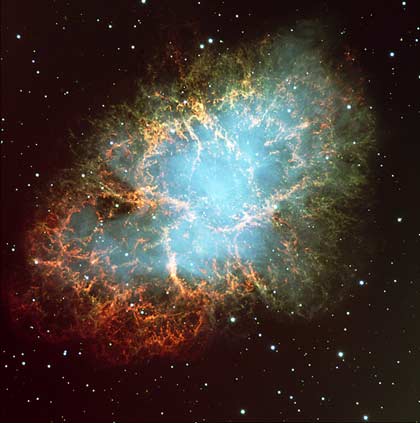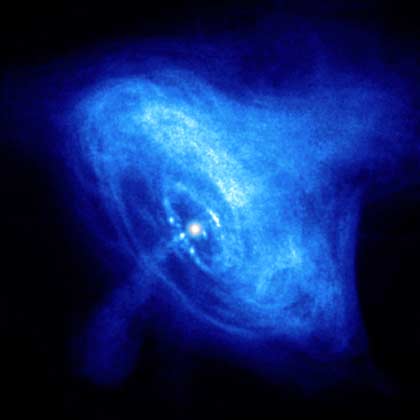Explosion of supernovae - Crab Nebula
According to a Chinese history book "Weak Meeting", on the morning of July 4, 1054, near the constellation Meteorite (Heavenly Gate) of the constellation Taurus appears "crystal guest" very bright . In the first 23 days its brightness exceeded Venus, still visible in the middle of the day. Later this star faded away, until April 6, 1056 completely shut down. This is the first meticulously recorded thing in the world about the big bang of the supernova. The crab nebula is the vestige of this big explosion of supernovae.
In the West, the crab nebula was discovered by astronomers in England in 1731. In 1884, Lord Ross (England) discovered that the shape of the nebula was like a large crab crawling across the sky, should be named Crab Nebula . That stubborn name exists today.

Crab Nebula (Photo: astroa.physics)
After the discovery of the Crab Nebula always caught the attention of astronomers. In 1921, Dunken - an American astronomer compared two nebula images taken 12 years apart, finding that the nebula is always expanding. In 1928, American astronomers measured the expansion rate of the Crab Nebula at 1,100km / sec. Many astronomers later confirmed that the Crab Nebula is the gaseous cloud created by the supernova explosion in July 1054.
The temperature of the Crab Nebula is not as hot as the Sun, but its radiation is very strong, in which the source of X-rays, radio waves, visible light and gamma rays are very strong. It is really a large capacity "Space Radio" . Where does this radiant energy come from? In 1968 astronomers removed from the "big belly" of the Crab nebula a peculiar "pearl" bead, the neutron star. This star is less than 20km in diameter but its weight is equivalent to the Sun. It has a very strong magnetic field, the surface temperature reaches 10 million degrees Celsius, the internal temperature is up to several hundred million degrees Celsius. The rotation speed is 30 revolutions per second. The pulse circuit is cyclic, in the Earth it can obtain its "molasses" . So neutron stars are also called stars Pulse circuits.

X rays in the Crab Nebula (Photo: chandra.harvard)
- Hubble sends a detailed image of the Crab Nebula
- 4 types of explosions create supernovae
- Things you didn't know about the Nebula
- Admire the beautiful array of astronomical images celebrating Hubble's 25 years old
- Blurred meteor detection
- The source of large energy radiation from the Crab Nebula
- The battle between two stars creates the brightest nebula in the Milky Way
- The most beautiful cosmic photos in 25 years
- The supernova explosion can destroy Earth from 50 light years
- A newly found giant crab
- What is Hypernova?
- Discovered nebula like engagement ring
 Van Allen's belt and evidence that the Apollo 11 mission to the Moon was myth
Van Allen's belt and evidence that the Apollo 11 mission to the Moon was myth The levels of civilization in the universe (Kardashev scale)
The levels of civilization in the universe (Kardashev scale) Today Mars, the sun and the Earth are aligned
Today Mars, the sun and the Earth are aligned The Amazon owner announced a secret plan to build a space base for thousands of people
The Amazon owner announced a secret plan to build a space base for thousands of people